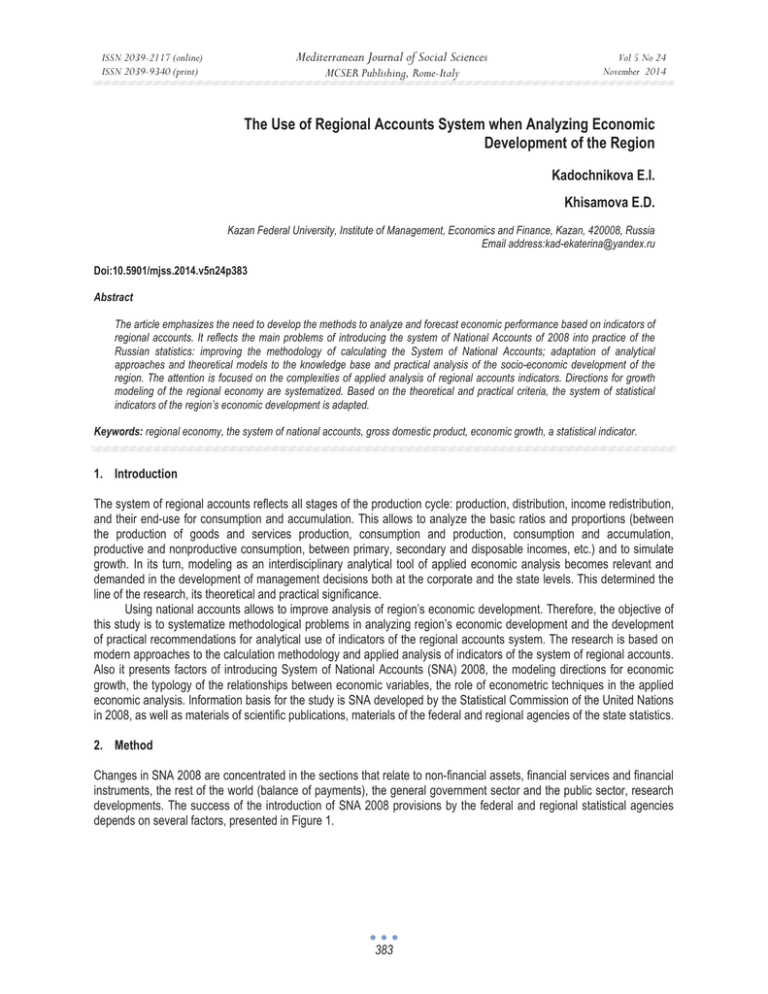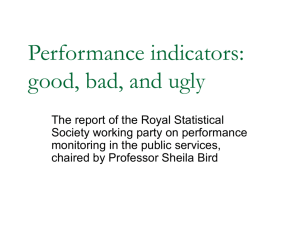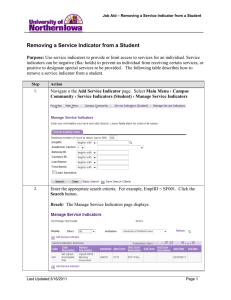The Use of Regional Accounts System when Analyzing Economic Kadochnikova E.I.
advertisement

Mediterranean Journal of Social Sciences ISSN 2039-2117 (online) ISSN 2039-9340 (print) MCSER Publishing, Rome-Italy Vol 5 No 24 November 2014 The Use of Regional Accounts System when Analyzing Economic Development of the Region Kadochnikova E.I. Khisamova E.D. Kazan Federal University, Institute of Management, Economics and Finance, Kazan, 420008, Russia Email address:kad-ekaterina@yandex.ru Doi:10.5901/mjss.2014.v5n24p383 Abstract The article emphasizes the need to develop the methods to analyze and forecast economic performance based on indicators of regional accounts. It reflects the main problems of introducing the system of National Accounts of 2008 into practice of the Russian statistics: improving the methodology of calculating the System of National Accounts; adaptation of analytical approaches and theoretical models to the knowledge base and practical analysis of the socio-economic development of the region. The attention is focused on the complexities of applied analysis of regional accounts indicators. Directions for growth modeling of the regional economy are systematized. Based on the theoretical and practical criteria, the system of statistical indicators of the region’s economic development is adapted. Keywords: regional economy, the system of national accounts, gross domestic product, economic growth, a statistical indicator. 1. Introduction The system of regional accounts reflects all stages of the production cycle: production, distribution, income redistribution, and their end-use for consumption and accumulation. This allows to analyze the basic ratios and proportions (between the production of goods and services production, consumption and production, consumption and accumulation, productive and nonproductive consumption, between primary, secondary and disposable incomes, etc.) and to simulate growth. In its turn, modeling as an interdisciplinary analytical tool of applied economic analysis becomes relevant and demanded in the development of management decisions both at the corporate and the state levels. This determined the line of the research, its theoretical and practical significance. Using national accounts allows to improve analysis of region’s economic development. Therefore, the objective of this study is to systematize methodological problems in analyzing region’s economic development and the development of practical recommendations for analytical use of indicators of the regional accounts system. The research is based on modern approaches to the calculation methodology and applied analysis of indicators of the system of regional accounts. Also it presents factors of introducing System of National Accounts (SNA) 2008, the modeling directions for economic growth, the typology of the relationships between economic variables, the role of econometric techniques in the applied economic analysis. Information basis for the study is SNA developed by the Statistical Commission of the United Nations in 2008, as well as materials of scientific publications, materials of the federal and regional agencies of the state statistics. 2. Method Changes in SNA 2008 are concentrated in the sections that relate to non-financial assets, financial services and financial instruments, the rest of the world (balance of payments), the general government sector and the public sector, research developments. The success of the introduction of SNA 2008 provisions by the federal and regional statistical agencies depends on several factors, presented in Figure 1. 383 ISSN 2039-2117 (online) ISSN 2039-9340 (print) Mediterranean Journal of Social Sciences MCSER Publishing, Rome-Italy Vol 5 No 24 November 2014 Figure 1. Introduction factors of SNA 2008 Due to the introduction of SNA 2008 provisions by the federal and regional statistical agencies there have been a number of issues that have to be solved to ensure the application of economic analysis [1, 2, 3, 4]. Firstly, the general methodological issues: - improving the method of calculating the consumption of fixed capital on the basis of the perpetual inventory method; evaluation of fixed assets at replacement cost; - harmonization between national accounts and other systems of macroeconomic indicators, in particular, statistics of public finance with the purpose of billing for the sector of state administration; - improving methods for the calculation of holding gains (losses); - improving methods for the determination of financial intermediation services which are measured indirectly; - improving the calculation of productivity measures reflecting the changes in the labor force; development of methodology for calculating the productivity of capital and total productivity. - Secondly, the methodological issues of evaluating SNA indicators: - harmonizing calculation of consumer price indices as expenditures deflators for the final consumption of households, the price indices for exports and imports of goods, price indexes for non-market services with the international standard; - harmonizing the methods for assessing the stock of assets, stocks, financial assets with the rules of SNA 2008; - improving the mechanism of estimating gross domestic product (GDP) and its components in real terms. Analysis of academic papers reveals two most important problems in the applied analysis of indicators of national accounts system. Firstly, multiple constraints on the relationship in the national accounts, on the possibility of changes in macroeconomic variables. There are two main areas of economic growth modeling [5,6,7,8]. The first one is connected with the construction of the production functions which link economic growth with the dynamics of the factors of production. The second one involves production modeling and consumption on the basis of multi-sectoral models and inter-sectoral balance [9]. In the first case, the economy is seen as an integral, unstructured unit. Resources are the arguments, and the gross output or gross domestic product is the function. In the second case, the economy is structured and consists of a finite number of sectors, or "clean" industries that produce one or more products. Economic growth is modeled on the basis of supply and demand balance in the economy. Since the relationship in the system of national accounts express logical links, modeling uses a system of equations. Expenditure of one economic agent is a resource of another one, and an equality between financial and non-financial resources and their use must be observed in respect of each economic agent. In the academic literature the typology of relationships between variables identifies economic static and dynamic connections, technical connections, connections in behavior and background connections [9,10]. Economic static and dynamic connections determine the relationship between variables and regularity of changes in some of them. Technical connections are determined by the production process. Connections in behavior reflect the presence of social habits, regularity in the actions of economic agents. Background connections are defined by regulation and legislation. Secondly, a major obstacle in the construction of regional econometric models is an insufficient number of observations to select the most proper dependencies and to estimate parameters, which is due to less completeness and consistency of regional statistics, shorter time series of data by the region. We agree with the fact that this circumstance 384 ISSN 2039-2117 (online) ISSN 2039-9340 (print) Mediterranean Journal of Social Sciences MCSER Publishing, Rome-Italy Vol 5 No 24 November 2014 limits to the construction of models which are least demanding to the source data [8,11]. The main information problems in regional calculations include the difficulty in obtaining information at the stage of the quarterly estimates for certain categories of enterprises; problems with the use of the residency concept, getting information about extra-regional territories; discrepancy in classification of activities when forming indicators of output, value added and wages across regions; the complexity of the re-adjustment of GRP in real terms. 3. Results The use of regional accounts together with econometric methods and expert judgments allows to have a more accurate and flexible way of forecasting and planning in justifying economic policies [6,12]. In a market economy, it is especially important to identify the phases of economic development based on long-term dynamics in order to determine the turning points that have prognostic properties. In this regard, the purpose of analyzing the development of the region is the prediction of changes in the phases of development. We propose a system of three summary statistical indicators of economic development in the region: 1.an aggregate leading indicator is a group of statistical indicators, for which index dynamics is preceded by changes in the index of industrial production. 2 an aggregate coinciding indicator is a group of statistical indicators, for which the index dynamics coincides with changes in the index of industrial production. 3 an aggregate lagging indicator is a group of statistical indicators, for which the dynamics of the index lags behind the changes in the index of industrial production. When selecting indicators included in each aggregate statistical indicator, we used a number of theoretical and practical criteria. Theoretical criteria include the economic rationale for the inclusion of an indicator in the group; a sufficiently deep description of the economic process selected; the maximum relevance of the indicator for the Russian economy. Practical criteria: frequency of publication (monthly data), timeliness (regular data), the duration of the series (a sufficient number of measuring points without interruption), stability (minimal risk of data revision). Based on these criteria, we have proposed indicators which reflect the development of the non-financial, financial sectors of the economy and the "rest of the world" (Table 1). Table 1. Indicator system of the region’s economic development ʋ Indicator Aggregate leading indicator 1. Oil price in the world market, USD/barrel 2. RTS index 3. Money supply M2, bn 4. Credit rates for non-financial organizations, % The output volume of mineral resources in the 5. region, ths.t The stock price of the leading companies in the 6. region 7. Gross value added in the region, mln. rub. 8. Inventories in organizations, mln. rub. Aggregate coinciding indicator The number of employed in the economy of the 9. region, th. pers. 10. Real disposable incomes, ths. rub. 11. Retail trade turnover, mln. rub. 12. Wholesale trade turnover, mln. rub. 13. Capital productivity in industry, rub. Aggregate lagging indicator The number of the unemployed in the region, 14. th. pers. Deposits of the population in the region, mln. 15. rub. 16. The retail price index in the region,% 17. The wholesale price index in the region, % 18. Investments in fixed assets, mln. rub. Sector of the economy Source of data “the rest of the world” Financial sector Financial sector Financial sector The Federal agency for state statistics The Russian trading system The Central bank of the Russian Federation The Central bank of the Russian Federation Non-financial sector The Regional office of the Federal agency for state statistics Financial sector The Russian trading system Non-financial and financial sectors Non-financial sector The Regional office of the Federal agency for state statistics The Regional office of the Federal agency for state statistics Non-financial and financial sectors The Regional office of the Federal agency for state statistics Non-financial and financial sectors Non-financial and financial sectors Non-financial and financial sectors Non-financial sector The Regional office of the Federal agency for state statistics The Regional office of the Federal agency for state statistics The Regional office of the Federal agency for state statistics The Regional office of the Federal agency for state statistics Non-financial and financial sectors The Regional office of the Federal agency for state statistics Financial sector The Central bank of the Russian Federation Non-financial sector Non-financial sector Non-financial and financial sectors The Regional office of the Federal agency for state statistics The Regional office of the Federal agency for state statistics The Regional office of the Federal agency for state statistics Cumulative indexes for each indicator are defined as a linear combination of the selected indicators: y = į1x1+ į 2x2 + ... + į jxj + ... + į nxn, (1) where y - the cumulative index, 385 ISSN 2039-2117 (online) ISSN 2039-9340 (print) Mediterranean Journal of Social Sciences MCSER Publishing, Rome-Italy Vol 5 No 24 November 2014 xj - the structural elements of the cumulative index, į j - weight with which structural elements are included in the cumulative index. Each indicator is included in the respective indicator with the defined weight. The weights can be determined on the basis of the correlation analysis between a particular indicator and the reference index of industrial production: where rij– paired correlation coefficient between the i index and j- reference index of industrial production (i, j = 1, 2, ..., n), Moreover, the pre-selected economic indicators are presented to dimensionless numbers, for example, chain index numbers which show growth rates. An important step is the adjustment of seasonal effects as in the summary reference index of industrial production, and in the components of each indicator. For the seasonal adjustment procedure the values of the seasonal component is calculated using the moving average method and the construction of additive or multiplicative time series model. Then each indicator is compared with the reference index and the main problem is solved, that is for how much dynamics of each indicator outpaces, coincides or lags behind the reference index of industrial production. This allows us to estimate the turning points in the business cycle, that is, periods which are characterized by a sharp decrease or increase in business activity. One can apply the calculation of functions interrelation between the time series of indicators and reference index of industrial production at various time lags. The lag for maximum cross-correlation coefficient indicates the period of advancing or lag. For coinciding indicator maximum correlation coefficient is, by definition, corresponds to the zero lag. It is also possible to apply methods of mathematical statistics to assess the simultaneity of statistical indicators. Loss of dynamics simultaneity of statistical indicators is a token of a turning point in the economic cycle. For statistical evaluation of the simultaneity degree of statistical indicators coefficient of concordance is used, the hypothesis of statistical insignificance in the concordance coefficient (randomness in the assessment of simultaneity) is checked with the help of Pearson criterion. Another approach to highlight the turning points is a trend analysis. First, you need to compare the actual values of the reference index of industrial production with trend values. The local maximum of the actual value ratio to the trend is a peak, and a local minimum is a trough, the peak and the trough are break points in the business cycle. The break points for statistical indicators are defined similarly and then they are compared with the reference indicators. 4. Conclusions Introduction of SNA 2008 requires a long period, and significant effort by the statistical agencies and other offices which are responsible for the formation of macro-economic statistics. Currently a number of changes in the definition and classification of some indicators, in the accounting and reporting, in the program of sample surveys are being introduced, there has been an increased interaction of statistical offices with the Ministry of Finance and the National Bank and coordination of their efforts to introduce the new SNA, government finance statistics and balance of payments. The use of econometric methods together with the national accounts allows to have a more accurate and flexible way of forecasting and planning when justifying economic policy. Based on the dynamics of statistical indicators in comparison with the reference index one can talk about trends in the economic development of the region. For example, a synchronous indicator speaks of the transition to economic growth, and the synchronous coinciding indicators testify of the stabilization of economic development, synchronous lagging indicators - sustainable economic development. The results obtained allow us to assess the trends in the economic development of the region based on indicators of the production account, to analyze the dynamics of the sectoral structure of output, standard of living, to make inter-regional comparisons, to develop strategic objectives of economic policy. References Ɍɧɟ System of National Accounts 2008. URL: http://unstats.un.org/unsd/nationalaccount/docs/SNA2008Russian.pdf Kadochnikova, E. I. Methodological issues of macroeconomic accouting // World Applied Sciences Journal. 24 (6), 2013. pp. 719-723. Erba, A. Economic structure and national accounting: G. Ortes' contribution to economic science (Review) // History of Economic Ideas. 19(1), 2011. pp. 55-83. Moulton, B.R. The system of national accounts for the new economy: What should change? // Review of Income and Wealth. 50 (2 SPEC. ISS.), 2004. pp. 261-278 Naveh, M.H., Torosyan, T., Jalaee, S.A. Regional Economic Integration and its Effects on Economic Growth and Economic Welfare // World Applied Sciences Journal 17 (10), 2012. pp. 1349-1355. Gerasimov, Ⱥ.N, Gromov, E.I, Levchenko, S.A., Skrebtsova, T.V, Kobozev M.A. Modeling and Forecasting of Key Indicators of Socio- 386 ISSN 2039-2117 (online) ISSN 2039-9340 (print) Mediterranean Journal of Social Sciences MCSER Publishing, Rome-Italy Vol 5 No 24 November 2014 Economic Development of Traditionally Agrarian Regions // World Applied Sciences Journal 27 (10), 2013. pp. 1282-1287. Thorns, D., Oxley, L.,. National accounting frameworks for measuring information and knowledge economies. Proc. iEMSs 4th Biennial Meeting - Int. Congress on Environmental Modelling and Software: Integrating Sciences and Information Technology for Environmental Assessment and Decision Making, iEMSs, (1), 2008. pp. 213-220. Barro R. J. Macroeconomics, 5th ed. 1997. Cambridge, MA: MIT Press. Aghion P., Howwit P. A model of growth through creative destruction // NBER 1050 Massachusetts, 1990. January. URL: http:// www.nber.org/ Jones, Charles I. Growth: With or Without Scale Effects. American Economic Review 89, May. 1999. pp.139-144. Grigoreva, E., Fesina, E. Economic Security as a Condition of Institutional Support of Economy Modernization // World Applied Sciences Journal. 31 (5). 2014. pp. 940-948. Barro, R. J., Gary, S. B. Fertility Choice in a Model of Economic Growth. Econometrica, 57, Marth,1999. pp.481-501. 387






